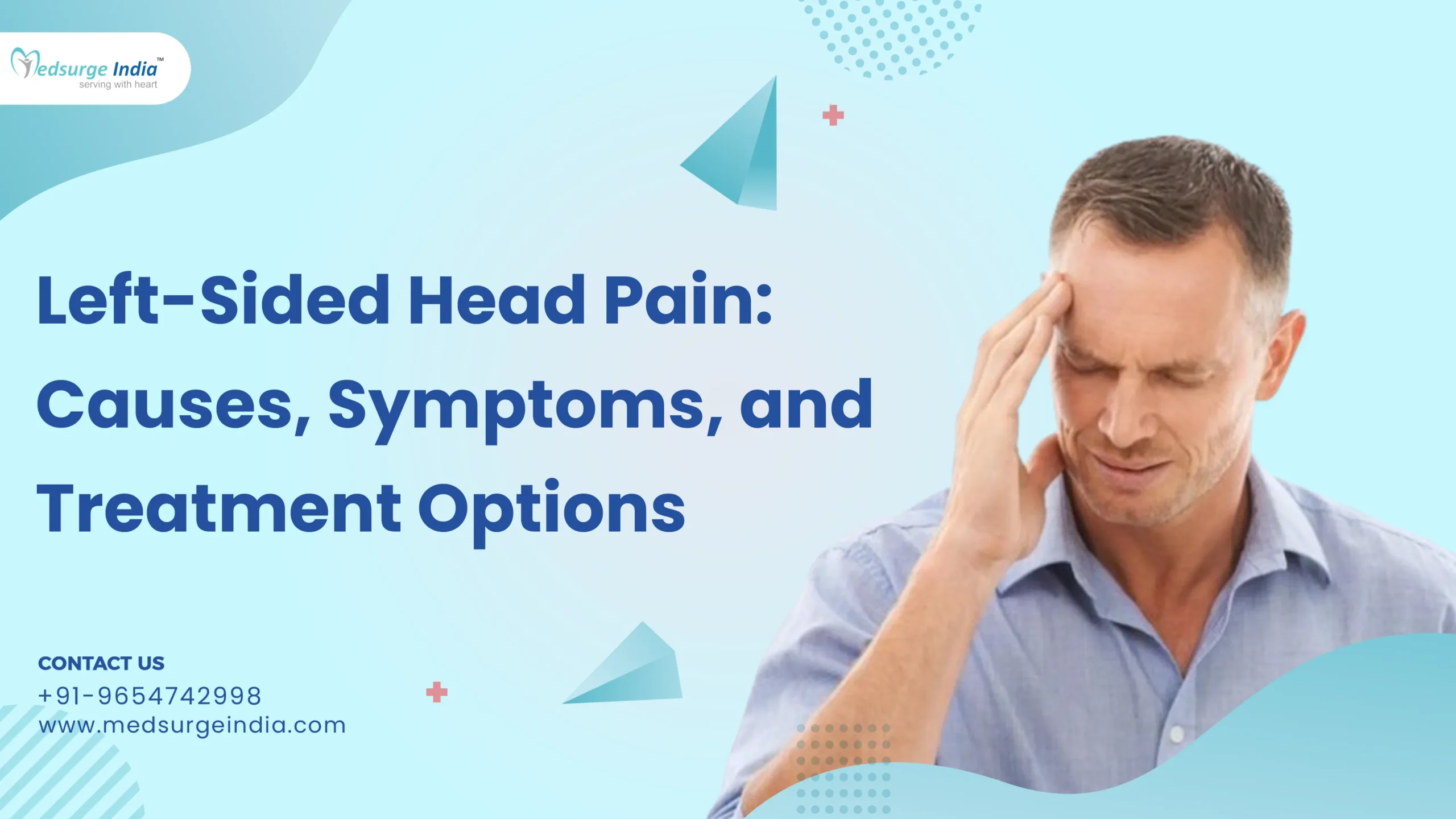
Left-Sided Headache: Causes, Symptoms, and Treatment Options
Various headaches can lead to discomfort on the left side of the head. Typically, this pain is not a cause for concern. However, if the pain is severe or persistent, it may indicate a more serious underlying issue.
Headaches can manifest in numerous forms, including migraines and tension headaches. Additionally, several factors could result in pain or pressure localized to the left side of your head.
It is important to note that while headaches can occur on one or both sides, experiencing pain specifically on the left side does not necessarily point to a particular medical condition.
Continue reading to explore potential causes and to understand when it is advisable to consult your healthcare provider.
What is a Headache?
Headaches are characterized by discomfort in the head or face, often described as a throbbing, persistent, sharp, or dull pressure. They can vary significantly in terms of pain type, intensity, location, and frequency.
This condition is prevalent, with the majority of individuals experiencing headaches multiple times throughout their lives. Headaches represent the most frequent type of pain and are a leading cause of missed work or school days, as well as consultations with healthcare professionals. Although most headaches are not harmful, some types may indicate a more serious underlying issue.
Types of head pain on the left side of the head
There are several types of headaches that may occur on the left side of the head:
1) Migraine
Migraine is a prevalent type of headache characterized by moderate to severe pain, often accompanied by symptoms such as nausea, vomiting, and heightened sensitivity to light and sound. The pain may affect one or both sides of the head and is typically described as a pulsating or throbbing sensation.
2) Tension
Tension headaches are the most frequently experienced type of headache, resulting from muscle tension in the head, neck, and scalp. Factors such as stress, poor posture, and other influences contribute significantly to the development of this muscle tension.
3) Cluster
Cluster headaches are uncommon and are marked by intense pain on one side of the head, typically around the eye or temple. The pain is often described as a burning or stabbing sensation. Additional symptoms may include a drooping eyelid, redness, and watering of the eye, nasal congestion or discharge, and swelling on the affected side of the face. These headaches tend to occur in “clusters,” manifesting multiple times a day over weeks or months, followed by periods of relief.
4) Sinus
Sinus headaches, while not very common, can be quite severe and are sometimes confused with migraines. They result from inflammation of the sinuses, which are the air-filled cavities within the skull. This inflammation can be triggered by infections, allergies, or other conditions that affect the sinuses.
5) Concussion
A concussion is a type of brain injury that may lead to headache pain on one side of the head. This occurs when the brain experiences a jolt or impact from a blow to the head, causing it to move or collide with the inner walls of the skull.
Conditions That Can Trigger a Left-Side Headache
Several significant medical issues may lead to a headache on the left side. These conditions encompass:
1) Infections
Intense, one-sided head pain may also arise from uncommon bacterial and viral infections impacting the head. Meningitis and encephalitis are two notable examples of such infections, both of which can result in severe headaches along with other significant symptoms. Meningitis refers to the infection of the membranes surrounding the brain, whereas encephalitis involves inflammation of the brain itself.
2) Allergies
Headaches on the left side of the head can be triggered by allergies. This occurs when specific substances, including certain foods, beverages, or environmental elements, provoke an immune response in the body, leading to sinus inflammation and subsequent pain in the forehead and cheeks.
3) Dissection of the Vertebral or Carotid Artery
A tear in these arteries can reduce blood flow to the brain, leading to sudden and severe headaches.
4) Brain Aneurysm
A bulging blood vessel in the brain that may rupture, causing intense, localized pain and neurological symptoms.
5) Temporal Arteritis
Inflammation of the arteries in the head often leads to throbbing headaches, vision changes, and jaw pain.
6) Meningitis
A serious infection causes inflammation of the membranes around the brain and spinal cord, leading to severe headaches, fever, and stiffness.
7) Encephalitis
Brain inflammation, often viral in origin, causes headaches, confusion, seizures, and flu-like symptoms.
8) Brain Tumor
An abnormal growth that can increase pressure inside the skull, resulting in persistent headaches, nausea, and vision disturbances.
9) Leak of Cerebrospinal Fluid (CSF)
A tear in the protective layers around the brain or spinal cord can cause positional headaches that worsen when standing.
10) Occipital Neuralgia
This is a rare and intensely painful headache that predominantly affects one side of the head. It occurs due to pressure on the occipital nerves, leading to sharp, throbbing pain in areas such as the neck, behind the ears, or at the back of the head.
11) Giant Cell Arteritis
This condition involves inflammation of the temporal artery located on the side of the forehead, which may also result in headaches on the left side. It poses significant risks, as it can impair blood circulation and lead to additional symptoms, including jaw pain, vision loss, fever, and fatigue.
12) Trigeminal Neuralgia
This is a chronic pain disorder stemming from damage to the trigeminal nerve, which may be caused by factors such as blood vessel compression, multiple sclerosis, stroke, or head injuries. The pain experienced in trigeminal neuralgia can vary from sudden, sharp episodes to a more persistent aching or burning sensation.
Lifestyle Factors That Can Trigger a Left-Side Headache
Unhealthy lifestyle habits may contribute to pain on the left side of the back of the head. Several factors related to lifestyle that can lead to headaches include:
- Nutrition: Missing meals or consuming certain foods and beverages may provoke migraines.
- Sleep patterns: A lack of adequate or regular sleep can result in migraines and headaches.
- Stress management: Elevated stress levels can act as a trigger for migraines.
- Environmental influences: Factors such as air pollution, strong scents, bright or flashing lights, and changes in weather can all induce headaches.
- Physical activity: While regular exercise can help prevent headaches, excessive physical strain may also lead to headache episodes.
Therefore, maintaining a healthy lifestyle is crucial for preventing headaches and avoiding other serious health issues.
Causes of Left-Side Headache
Several common factors can lead to left-side headaches:
Tension or Stress: Headaches on the left side may arise from stress or tension, often experienced as a constricting sensation around the head.
Eye Strain: Extended periods of screen use or reading without adequate breaks can result in left-side headaches due to eye fatigue.
Dehydration: Not drinking enough water can trigger headaches, with dehydration potentially causing pain on the left side.
Sinus Issues: Congestion or infections in the sinuses can lead to left-side headaches, frequently accompanied by discomfort in the facial area.
Cervicogenic Headaches: Problems in the neck, such as tension or poor posture, can result in cervicogenic headaches that manifest on the left side.
Migraines: Left-sided migraines may present as throbbing pain, along with symptoms like nausea and heightened sensitivity to light or sound.
Cluster Headaches: Characterized by severe, stabbing pain on the left side, cluster headaches often occur in groups.
Temporal Arteritis: Inflammation of the temporal artery can cause left-side headaches, which may also be linked to jaw pain.
Hormonal Factors: Hormonal fluctuations, particularly in women, can play a role in the occurrence of left-side headaches.
Sleep Disturbances: Irregular sleep patterns or lack of sleep can trigger headaches on the left side.
Weather Changes: Sensitivity to changes in weather, such as shifts in atmospheric pressure, can lead to discomfort on the left side of the head.
Caffeine Withdrawal: A sudden decrease in caffeine consumption may result in left-side headaches for some individuals.
Treatment for Left-Side Headache
There are several treatment options available for alleviating left-side headaches. Below are some effective therapies to consider.
1) Massage Therapy:
A gentle massage targeting the neck, shoulders, and scalp, especially on the left side, can help relieve muscle tension and enhance blood flow. A qualified massage therapist can focus on specific areas to reduce tension that may be contributing to left-side headaches.
2) Cognitive Behavioral Therapy (CBT):
This form of talk therapy aims to identify and modify negative thought patterns and behaviors. If emotional factors such as stress or anxiety are linked to left-side headaches, CBT can assist in addressing these underlying issues. A mental health professional can facilitate this therapeutic journey.
3) Physical Therapy:
For those whose headaches stem from musculoskeletal problems like tension or poor posture, physical therapy can be advantageous. A physical therapist can evaluate the condition of your neck and shoulder muscles, recommend exercises to boost strength and flexibility, and teach techniques for improved body mechanics. By tackling these physical contributors, the frequency and severity of left-side headaches may be diminished.
When to See a Doctor?
If you are suffering from ongoing or intense headaches on the left side that disrupt your daily activities, it is recommended to seek advice from a healthcare professional. This is particularly crucial in certain situations, including:
- Headaches that occur frequently
- Presence of additional symptoms such as nausea, vomiting, visual changes, or neurological concerns
- Impact on your daily routine
- Sudden onset with significant severity
- A background of health issues such as migraines, hypertension, or other medical conditions
- Any alterations in the frequency, intensity, or characteristics of your headaches should be addressed with a healthcare provider.
Know More:- Head and Neck Cancer – Types, Causes and Diagnosis
Conclusion
Many headaches can be effectively controlled through the use of pain relief medications and adjustments to one’s lifestyle.
Nevertheless, some individuals suffer from persistent primary headaches that disrupt their daily activities. In such cases, they must collaborate with their healthcare provider to identify a treatment plan that alleviates their discomfort.
When headaches stem from an underlying medical issue, consulting a physician promptly can facilitate timely and appropriate treatment, often resulting in a better prognosis.











